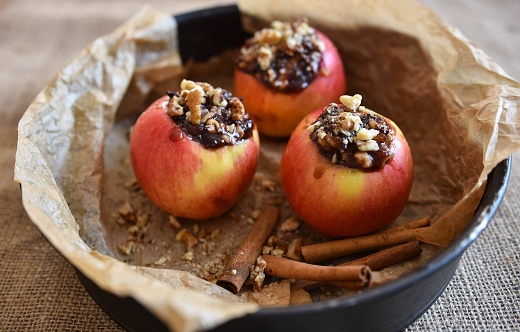 This is definitely my favorite time of year: football, cooler weather, and the return of all things apple and pumpkin. Not only are they chock-full of vitamins and other healthy goodness, but they are also delicious!
This is definitely my favorite time of year: football, cooler weather, and the return of all things apple and pumpkin. Not only are they chock-full of vitamins and other healthy goodness, but they are also delicious!
Apples: Benefits and a Recipe
The old quote “an apple a day keeps the doctor away” could not be more correct. This fruit is loaded with fiber (a typical tennis ball–sized piece has 4 filling fiber grams), which helps to keep you satisfied. They are also high in immune-boosting Vitamin C. One recent study found that eating apples was directly linked to having a lower incidence of death from coronary heart disease and cardiovascular disease.
Another surprising benefit of this fruit is that they may boost your endurance during a workout. The antioxidant quercetin makes oxygen more available in the lungs, and one study showed that individuals who had this antioxidant prior to a workout were able to cycle longer.
Grab one for a snack or try this delicious dessert.
Baked Cinnamon Apples
Ingredients:
4 large good baking apples, such as Rome Beauty, Golden Delicious, or Jonagold
1/4 cup brown sugar
1 teaspoon cinnamon
1/4 cup chopped pecans
1/4 cup raisins
1 Tbsp butter
3/4 cup boiling water
Directions:
- Preheat oven to 375°F. Wash apples. Remove cores to a half-inch of the bottom of the apples. Make the holes about 3/4 inch to an inch wide.
- In a small bowl, combine the sugar, cinnamon, raisins, and pecans.
- Place apples in an 8-inch-by-8-inch square baking dish. Stuff each apple with this mixture. Top each with a dot of butter (1/4 Tbsp). Add boiling water to the baking pan.
- Bake 30–40 minutes, until tender but not mushy. Remove from the oven and enjoy!
Serves 4.
Calories: 230; Fat: 8g; Fiber: 6g. Recipe adapted from Simply Recipes.
Pumpkin Spice and Everything Nice
Pumpkins have just as much to brag about as apples do. Pumpkin is loaded with Vitamin A, which is essential for boosting your immune system, vision health, and bone health. You also get a significant amount of potassium from pumpkin. This helps keep your fluid and mineral balance regulated, which helps with heart function.
That bright orange color from pumpkin means it is high in the antioxidant betacarotene. This means it is heart protective and can help lower your risk for heart disease. Finally, just like apples, pumpkin is loaded with fiber. Each cup of pureed pumpkin has 7 grams of fiber. That’s one-third of your daily needs!
I like to use pureed canned pumpkin as a fat replacer in cake mixes, brownies, and muffin mixes. Just substitute the same amount of pumpkin for the oil called for in recipes and enjoy a lower-fat and nutritious treat. Here is a wonderful quick dessert to whip up, too.
Pumpkin Mousse
Ingredients:
3 cups cold fat-free milk
2 pkg. (1.5 oz. each) vanilla flavor fat-free, sugar-free instant pudding
1 can (15 oz.) pumpkin
1 tsp. pumpkin pie spice
1 cup thawed fat-free whipped topping
Directions:
- Beat milk and pudding mix in medium bowl and whisk for 2 minutes.
- Blend in pumpkin and spice.
- Stir in whipped topping.
- Refrigerate for 1 hour before serving.
- Makes 12 half-cup servings.
Calories: 60; Total Protein: 3g; Total Fat: 1g. Recipe adapted from Kraft Recipes.
Enjoy these fabulous fall superfoods while they are plentiful, and give your autumn nutrition a boost!
This blog was written by Angie Mitchell, RD, Wellness Coordinator. To find out more about the NIFS bloggers, click here.


 One of my favorite things to do during summer in Indiana is to visit the various farmers’ markets around the Indianapolis area. As a dietitian I am a sucker for the fresh fruits and veggies, but I also love the homemade desserts, candles, pasta, kettle corn, fresh flowers, and other wonderful items you can find.
One of my favorite things to do during summer in Indiana is to visit the various farmers’ markets around the Indianapolis area. As a dietitian I am a sucker for the fresh fruits and veggies, but I also love the homemade desserts, candles, pasta, kettle corn, fresh flowers, and other wonderful items you can find. You’ve seen it on the news and read articles in magazines, but is it really true? Can chocolate actually be good for you? Isn’t it too delicious and forbidden to be a food that can help with heart disease? Of course nutrition is confusing and things change all the time about what is good and isn’t so good for you, so what is the deal with chocolate?
You’ve seen it on the news and read articles in magazines, but is it really true? Can chocolate actually be good for you? Isn’t it too delicious and forbidden to be a food that can help with heart disease? Of course nutrition is confusing and things change all the time about what is good and isn’t so good for you, so what is the deal with chocolate?  Cocoa naturally has a very strong taste, so it has to go through many steps to form your favorite type of chocolate. And through this processing many of the flavanols are lost. Most commercial chocolates are highly processed, and therefore have the lowest amount of antioxidants. However, dark chocolate that has undergone minimal processing will have the highest amount of flavonoids. As far as cocoa goes, the best choice is one that hasn’t undergone Dutch processing, which is when they treat it with an alkali to neutralize the natural acidity. (For more about how chocolate is created and how to enjoy it, check out
Cocoa naturally has a very strong taste, so it has to go through many steps to form your favorite type of chocolate. And through this processing many of the flavanols are lost. Most commercial chocolates are highly processed, and therefore have the lowest amount of antioxidants. However, dark chocolate that has undergone minimal processing will have the highest amount of flavonoids. As far as cocoa goes, the best choice is one that hasn’t undergone Dutch processing, which is when they treat it with an alkali to neutralize the natural acidity. (For more about how chocolate is created and how to enjoy it, check out